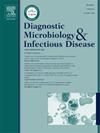雅培Alinity抗hbc免疫测定的临床表现及其与肝纤维化风险分层中FIB-4评分的关联
IF 1.8
4区 医学
Q3 INFECTIOUS DISEASES
Diagnostic microbiology and infectious disease
Pub Date : 2025-07-17
DOI:10.1016/j.diagmicrobio.2025.117018
引用次数: 0
摘要
乙型肝炎病毒(HBV)感染仍然是一个主要的全球健康问题,特别是在免疫功能低下的个体中,由于病毒再激活的风险。抗HBc抗体是过去或正在感染的关键标志物。本研究评估了雅培Alinity抗hbc检测的诊断性能,并研究了抗hbc阳性的临床意义,特别是与肝纤维化的关系。方法对2022年11月至2023年12月在巴黎圣约瑟夫医院检测的10377份抗hbc血清样本进行回顾性横断面研究。在不同的患者群体中,包括免疫功能低下和高危人群中,分析了抗hbc指数值、HBsAg状态、HBV DNA病毒载量和纤维化严重程度(通过FIB-4指数)之间的相关性。结果15.3%的样本呈抗- hbc阳性。重测对含S/CO >样品的解释无影响;2. 在hbsag阳性和DNA hbv阳性样本中,抗hbc水平明显较高。免疫功能低下患者的抗hbc指数较低。较高的FIB-4指数与抗HBc阳性相关,提示既往HBV感染与晚期纤维化风险增加之间存在潜在联系。抗hbc水平与HBV DNA病毒载量或HBsAg指数无相关性。结论:雅培Alinity抗hbc检测表现出很强的性能,在灰色区域之外几乎不需要重新检测。抗- hbc阳性可能作为肝纤维化的独立危险因素,强调其在HBV监测中的重要性,特别是在免疫功能低下的患者中。临床指南可以考虑量身定制的重新检测策略,并强调核酸检测对HBV的全面评估。本文章由计算机程序翻译,如有差异,请以英文原文为准。
Clinical performance of the Abbott Alinity anti-HBc immunoassay and its association with FIB-4 score in risk stratification of liver fibrosis
Background
Hepatitis B virus (HBV) infection remains a major global health concern, especially in immunocompromised individuals due to the risk of viral reactivation. Anti- HBc antibodies serve as key markers of past or ongoing infection. This study evaluated the diagnostic performance of the Abbott Alinity anti-HBc assay and investigated the clinical significance of anti-HBc positivity, particularly in relation to liver fibrosis.
Methods
A retrospective, cross-sectional study was conducted on 10,377 serum samples tested for anti-HBc at Paris Saint Joseph Hospital between November 2022 and December 2023. The correlation between anti-HBc index values, HBsAg status, HBV DNA viral load, and fibrosis severity (via FIB-4 index) was analyzed across various patient populations, including immunocompromised and at-risk groups.
Results
Anti-HBc positivity was observed in 15.3 % of samples. Retesting had no impact on interpretation for samples with S/CO > 2. Anti-HBc levels were significantly higher in HBsAg-positive and DNA HBV-positive samples. Immunocompromised patients showed lower anti-HBc indices. A higher FIB-4 index was associated with anti- HBc positivity, suggesting a potential link between past HBV infection and increased risk of advanced fibrosis. No correlation was found between anti-HBc levels and HBV DNA viral load or HBsAg index.
Conclusion
The Abbott Alinity anti-HBc assay demonstrates strong performance, with minimal need for retesting outside the gray zone. Anti-HBc positivity may serve as an independent risk factor for liver fibrosis, underlining its importance in HBV surveillance, especially in immunocompromised patients. Clinical guidelines may consider tailored retesting strategies and emphasize nucleic acid testing for comprehensive HBV evaluation.
求助全文
通过发布文献求助,成功后即可免费获取论文全文。
去求助
来源期刊
CiteScore
5.30
自引率
3.40%
发文量
149
审稿时长
56 days
期刊介绍:
Diagnostic Microbiology and Infectious Disease keeps you informed of the latest developments in clinical microbiology and the diagnosis and treatment of infectious diseases. Packed with rigorously peer-reviewed articles and studies in bacteriology, immunology, immunoserology, infectious diseases, mycology, parasitology, and virology, the journal examines new procedures, unusual cases, controversial issues, and important new literature. Diagnostic Microbiology and Infectious Disease distinguished independent editorial board, consisting of experts from many medical specialties, ensures you extensive and authoritative coverage.

 求助内容:
求助内容: 应助结果提醒方式:
应助结果提醒方式:


